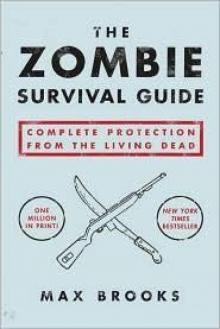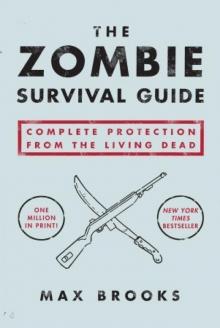- Home
- Max Brooks
The Zombie Survival Guide: Complete Protection From the Living Dead Page 16
The Zombie Survival Guide: Complete Protection From the Living Dead Read online
Page 16
TERRAIN TYPES
Examine a map of the world and find the best land and mildest climate. Overlay it with the densest population, and you will see a perfect match-up. Early humans knew what to look for when they began to build communities: moderate weather, fertile soil, plentiful fresh water, and a bounty of natural resources. These prime spots became the first centers of humanity, expanding outward into the modern population centers we know today. It is this way of thinking, this perfectly logical thought process, that you will have to completely abandon when choosing your new home. Back to the map. Say you find a place that looks immediately attractive. Chances are that several million people will be thinking the same thing when their time comes to flee. Combat this thinking with the slogan “harsher is safer,” and to be as safe as possible, you will have to find the harshest, most extreme places on Earth. You will have to find an area that looks so unattractive, so inhospitable, that the last thing you would ever want to do is call it home. The following list of environments is provided to aid you in making an informed choice. Supplementary texts will give you more detailed information concerning their exact weather patterns, available food, water, natural resources, and so on. What this section demonstrates is how they relate to all the factors associated with an undead world.
1. DESERT
Second only to the polar regions, this is one of the harshest and, therefore, safest environments in the world. Despite what we see in movies, deserts are rarely oceans of sand. Rocks can easily be broken and shaped for building comfortable homes and, more important, defensive walls. The more remote your camp is, the greater chance it will have of avoiding raiders. These renegade scavengers will not be interested in riding across any deep desert where they know no major outposts exist. What would be the point? Even if some tried, the intense heat and lack of water would probably kill them off before they even reached your camp. Zombies, on the other hand, would not suffer from this problem. Heat and thirst are not part of the equation. The dry air would retard their already-slowed decomposition. If the chosen desert is situated between populated areas, such as those in the American Southwest, there will be a very real chance of some discovering your compound. Unless you build your fortification on top of a hill or large rock formation, the flat terrain will increase the need for artificial defenses.
2. MOUNTAINS
Depending on their location and elevation, this environment offers excellent defense against the living dead. The steeper the slope, the harder it will be for them to climb. If the mountain in question has no roads or wide paths, human bandits might also be deterred. Although high elevation allows a better view of the surrounding countryside, it also makes camouflage more difficult. Visual-concealment measures must be a top priority, especially where lights and smoke are concerned. Another drawback of the strategic high ground is its distance from usable resources. Commuting to level ground for food, water, and building materials will compromise your security. Consequently, the mountaintop you choose may not be the highest or easily defended but must contain all you need to survive.
3. JUNGLE
The opposite of deserts, jungles or tropical rainforests will provide all the water, food, and building materials you need as well as a host of medicinal vegetation, burning fuel, and instant camouflage. The thick foliage acts as a noise buffer, insulating sounds that would travel miles in the open. Unlike what we saw in “On the Attack,” where the terrain will work against a team of hunters, the absence of visibility and muddy earth are perfectly suited for a defensive posture. Bandit groups can be easily ambushed and destroyed. Individual zombies can be dispatched without alerting others. There are, of course, negatives associated with this equatorial ecosystem. Moisture breeds life, which includes millions of species of bio-organisms. Disease will be a constant threat. Any cuts or scrapes could turn rapidly gangrenous. Food will decompose much more quickly than in drier climates. Metal gear must be watched for rust. Any clothing not rubberized or otherwise treated will rot, literally, off your back. Mold will be everywhere. The local insect population will be your most constant enemy. Some will be mere nuisances; some may have painful, even fatally venomous stings. Some will carry horrible diseases such as yellow fever, malaria, or dengue fever. One positive natural aspect of jungle survival is that the intense moisture, coupled with the multitude of microscopic organic life, accelerates undead decomposition. Field tests have shown at least a 10 percent higher decay rate in jungle-bound zombies. In certain cases, the percentage has been as high as 25! What all these factors equal out to is an environment with many natural hardships but one extremely well-suited to worst-case survival.
4. TEMPERATE FORESTS
This worldwide zone is easily the most comfortable for long-term survival. However, with such attractive land will come a host of problems. The wilds of Northern Canada are sure to be crowded with refugees. Caught unprepared, these panicked mobs will surely flee north. For at least the first year, they will roam the wilderness, stripping the land of food, turning to violence to obtain equipment, perhaps even turning to cannibalism in the cold winter months. Brigands will no doubt be among them or will follow in the later years when some decide to attempt a safe settlement. And of course, there is always the zombie threat. Temperate forests are still relatively close to civilization, as well as being dotted with outposts of humanity. Ghoul encounters would be ten times as likely as under normal circumstances. With an influx of refugees, the chances of the undead simply following them north is almost a given. Remember also, the problem of zombies freezing in the winter and thawing in the summer. Choose an area only if it is isolated by natural boundaries: mountains, rivers, and so on. Anything less—even if it seems far from humanity—will be too much of a risk. Do not believe that the vast expanse of Siberia will be any safer than Northern Canada. Remember, to the south of this thinly peopled wilderness are both India and China, the two most populous nations on Earth.
5. TUNDRA
Refugees will not consider these seemingly barren lands capable of supporting life. Those who try will perish without large stores of supplies, elaborate equipment, or extensive knowledge of the environment. Bandits will also be hard-pressed to survive. In all probability, none will venture this far north. The living dead may reach your camp, however. Those that have migrated north following fleeing refugees, or former refugees now reanimated as zombies, may detect your presence and signal others. Their numbers will not be great and can be handled by those in your group. All the same, build your defenses strong and keep constant vigilance. As with temperate forests, be prepared for zombie activity to follow the seasons.
6. POLAR
This environment is, without a doubt, the harshest on the planet. Extremely low temperatures with a high wind chill can kill an exposed human in seconds. Building materials will consist mainly of ice and snow. Fuel will be scarce. Medicinal or any other type of plants are unheard of. Food is plentiful but takes skill and experience to obtain. Even in summer, hypothermia will be a constant danger. Every day will be spent on the fringe of existence. One mistake regarding food, clothing, shelter, even hygiene could mean certain death. Many people have heard of Allariallak, the Inuit whose life in the frozen Hudson Bay region was documented in the film Nanook of the North. Few know that “Nanook” starved to death a year after that documentary was shot. This is not to say that life in the polar regions is an impossibility. People have been doing it successfully for thousands of years. What it will take is ten times the knowledge and determination to even attempt a life at the top or bottom of the world. If you are not ready to spend at least one winter practicing under these conditions, do not try it when the time to flee comes. So why go? Why risk death from such a hostile environment when the goal is to stay alive? The truth is that the environment should be your only worry. Refugees and bandits will never make it that far. The chance of zombies randomly wandering that far north are one in 35 million (a proven calculated statistic). As with temperate forests and tundra, you do ru
n the risk of an odd ghoul freezing and thawing in its travels. If you are camped near a coastline, watch for one possibly brought ashore by the current or a derelict-infested ship. Coastlines also leave you vulnerable, in the beginning, to pirates. (More on this concerning islands.) Maintain some means of static defense and always keep alert, although the need for both is relatively less than for any other environment.
7. ISLANDS
What could be safer than land surrounded on all sides by water? Zombies can’t swim. Doesn’t that mean living on an island is the obvious choice for a worst-case scenario? To some degree, yes. Its geographical isolation does negate the possibility of mass zombie migration, something that must be taken into account when billions will be prowling every continent on the globe. Even islands a few miles offshore will save you from the writhing, clamoring hordes. For this reason alone, islands are always a preferable choice. However, just because you decide to live on a rock surrounded by water does not guarantee your survival. Offshore islands will be the obvious choices for refugees. Anyone with a boat or raft will make for them. Ruffians will use them as bases from which to conduct raids on the mainland. Offshore islands may also be destroyed by industrial accidents, some well inland that dump pollution into nearby rivers. To avoid these immediate dangers, choose an island accessible only by a sturdy craft and expert navigation. Look for one without a good natural harbor or too many accessible beaches. This will make it less attractive to other seaborne refugees attempting the same strategy as you. (Remember, purchasing an island will keep people away only before the crisis! No starving, frantic refugee ship is going to obey a “keep out” sign.) Look for islands with high cliffs and, if possible, wide, dangerous reefs.
Even with these natural boundaries, construct defenses and maintain concealment. Dangers are still out there! Pirates, in the beginning phases of the crisis, may cruise from island to island, hoping to scavenge what they can from survivors. Always keep a lookout for their ships on the horizon. Zombies, too, may come in many forms. With the world completely infested, many will certainly find themselves roaming the floors of our oceans. There is the possibility, slight though it may be, of one lumbering up the underwater slope that leads to your little coastline. Others still wearing lifejackets from mortal life may be carried to your island by the current. Then there is the chance of a zombie-infested ship, and in a worst-case scenario, there could be one wrecking on your shore and spilling its deadly cargo. No matter what, do not destroy your means of escape. Drag your boat onto the beach or keep it camouflaged offshore. Losing it will mean turning your fortress into a prison.
8. LIVING BY SEA
It has been suggested that, with the right vessel and crew, a group could survive a worst-case scenario entirely at sea. Theoretically, this is possible, but the odds of its success are astronomical. In the short run, many people will take to water in everything from two-person sailboats to 80,000-ton freighters. They will survive on what they have brought aboard, scavenging the world’s infested ports, catching fish, and distilling fresh water if possible. Pirates in fast, armed private boats will roam the seas. These modern-day buccaneers already exist today, robbing freighters and yachts along many Third World coastlines and even strategic choke points. In a worst-case scenario, their numbers will swell to several thousand, and their targets will not be exclusive. As military ports become overrun, warships not supporting ground operations will set sail for safer anchorage. In these remote atoll bases, the world’s navies will wait for the crisis to pass, and wait, and wait.
After several years, time and the elements will take their toll on these ad-hoc seaborne populations. Ships relying on fossil fuel will eventually run dry, doomed to drift helplessly. Some attempting to scavenge from abandoned ports and fuel depots may meet their end as zombie food. As medicines and vitamins run out, diseases such as scurvy will begin to take their toll. Rough seas will destroy many vessels. Pirates will eventually burn themselves out through infighting, clashes with victims who choose not to be victimized, and encounters with the occasional living dead. This last contingency will also lead to raider infection, increasing the danger of seaborne undead. Derelict, zombie ghost ships will float aimlessly across the world’s oceans, their moans carrying on salty wind. This wind will eventually erode delicate machinery, including those that purify water and generate power. Within several years, only a few dedicated sailing ships will ride the waves. All others will be sunk, wrecked, reanimated, or will have simply dropped anchor in some remote beach, determined to make a go of it on land.
Anyone even entertaining the idea of a seaborne existence must have the following assets:
A.
At least ten years of experience at sea, either in commercial or military service. Simply owning a cabin cruiser for that amount of time does not qualify.
B.
A sturdy, wind-powered craft, at least one hundred feet or more with equipment constructed mainly of nonorganic, noncorrosive material.
C.
The ability to distill fresh water on a constant basis without relying on rain! Not only must your system and device be simple, easy to maintain, and resistant to rust, but you must also have a backup system aboard.
D.
The ability to catch and prepare food without the use of non-renewable fuel. In other words, no propane stove.
E.
Complete knowledge of every aquatic plant and animal. All vitamins and minerals obtained on land can be replaced by a seaborne substitute.
F.
Full emergency equipment for everyone in your group should the need to abandon ship arise.
G.
Knowledge of the location of a safe haven. All boats need a port, no matter how primitive. It could be a collection of rocks off Canada or some barren atoll in the Pacific. No matter what it is, unless you know where your port in a storm is, you are, literally and figuratively, sunk.
With all these in place, it might be easier to simply compromise your living conditions. Use your boat as a movable home as you forage from small island to island, or coastline to coastline. This will be a more comfortable, safer existence than on the open sea. Even so, keep a watch for zombies in shallow water, and always, always, watch your anchor line! Theoretically, this type of life is possible, but it is not recommended.
DURATION
How long will you have to endure this primitive existence? How long before the walking dead simply crumble to dust? How long before life can return to even a semblance of normality? Sadly, there is no exact figure. The first zombie to rise will, unless it is frozen, embalmed, or otherwise preserved, completely decompose after five years. However, by the time the undead have world domination, ten years might have already passed. (Remember, you will be fleeing when the war begins, not at its end.) When zombies truly dominate the planet, and there are no more fresh humans to infect, it will truly take five years for the majority of them to rot away. Dry climate and freezing will preserve many, keeping them functional for, potentially, decades. Bandits, refugees, and other survivors like yourself may become further prey, adding a newer but smaller generation to the older, decaying horde. By the time these turn to dust, the only undead left will be those preserved artificially or constantly refrozen with each winter. These you will have to watch for decades to come. Your children and even your children’s children will have to be wary of them. But when will it be safe to come out?
Year 1: A state of emergency is declared. You flee. Your defenses are built; your compound is established. Labor is divided. A new life begins. All this time, you monitor radio and television broadcasts, keeping a close watch on the unfolding conflict.
Year 5–10: Somewhere within this time period, the war ends. The dead have won. The signals stop. You assume that the entire world is overrun. You continue your life, keeping a close eye on defense as bandits and refugees might begin to enter your zone.
Year 20: After two decades of isolation, you consider sending a scouting party. Doing so will ri
sk discovery. If the party does not return by a fixed date, you assume they have been lost, perhaps even divulged your location. You stay hidden. Do not send out another search party, and prepare for battle. Another party will not be sent out for at least five years. If the scouts do return, their findings will determine your next course of action.
Your scouts will discover a new world in which one of three scenarios prevails:
1.
Zombies still roam the earth. Between those artificially preserved and those freezing with each winter, millions continue to exist. Although they may be infrequent, one per two square miles, they are still the planet’s dominant predator. Almost all humanity is gone. Those who survive remain in hiding.
2.
Few undead remain. Decomposition and constant warfare have taken their toll. Perhaps every hundred or so miles, a lone zombie will be spotted. Humanity has begun to make a comeback. Pockets of survivors have banded together and are striving to rebuild society. This could take many forms, from a harmonious collective of law-abiding citizens to the chaotic, feudal society of barbarians and warlords. The latter would be reason enough to stay hidden. There is the possibility, no matter how slight, that all or some governments-in-exile will eventually show their faces. Armed with the remnants of military and police, equipped with stored technology and archived know-how, they attempt, successfully, to set humanity on a slow but steady course to re-establishing global dominance.

 World War Z: An Oral History of the Zombie War
World War Z: An Oral History of the Zombie War Minecraft: The Island
Minecraft: The Island The Zombie Survival Guide: Complete Protection From the Living Dead
The Zombie Survival Guide: Complete Protection From the Living Dead Closure, Limited and Other Zombie Stories
Closure, Limited and Other Zombie Stories Devolution: A Firsthand Account of the Rainier Sasquatch Massacre
Devolution: A Firsthand Account of the Rainier Sasquatch Massacre The Zombie Survival Guide
The Zombie Survival Guide World War Z
World War Z Closure, Limited
Closure, Limited The Zombie Survival Guide: Recorded Attacks
The Zombie Survival Guide: Recorded Attacks World War Z_An Oral History of the Zombie War
World War Z_An Oral History of the Zombie War The Essential Max Brooks: The Zombie Survival Guide and World War Z
The Essential Max Brooks: The Zombie Survival Guide and World War Z